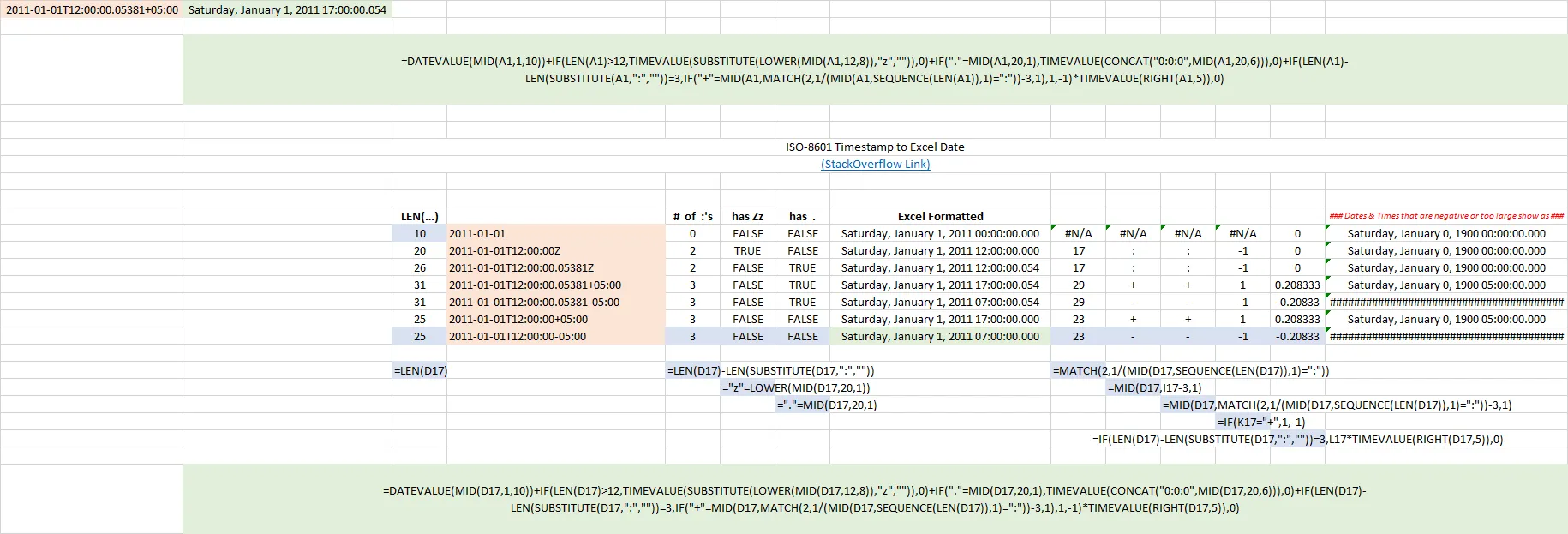rix0rrr的答案很好,但不支持没有冒号或仅带小时的时区偏移量。我稍微改进了这个函数以支持这些格式:
'---------------------------------------------------------------------
' Declarations must be at the top -- see below
'---------------------------------------------------------------------
Public Declare Function SystemTimeToFileTime Lib _
"kernel32" (lpSystemTime As SYSTEMTIME, _
lpFileTime As FILETIME) As Long
Public Declare Function FileTimeToLocalFileTime Lib _
"kernel32" (lpLocalFileTime As FILETIME, _
lpFileTime As FILETIME) As Long
Public Declare Function FileTimeToSystemTime Lib _
"kernel32" (lpFileTime As FILETIME, lpSystemTime _
As SYSTEMTIME) As Long
Public Type FILETIME
dwLowDateTime As Long
dwHighDateTime As Long
End Type
Public Type SYSTEMTIME
wYear As Integer
wMonth As Integer
wDayOfWeek As Integer
wDay As Integer
wHour As Integer
wMinute As Integer
wSecond As Integer
wMilliseconds As Integer
End Type
'---------------------------------------------------------------------
' Convert ISO8601 dateTimes to Excel Dates
'---------------------------------------------------------------------
Public Function ISODATE(iso As String)
' Find location of delimiters in input string
Dim tPos As Integer: tPos = InStr(iso, "T")
If tPos = 0 Then tPos = Len(iso) + 1
Dim zPos As Integer: zPos = InStr(iso, "Z")
If zPos = 0 Then zPos = InStr(iso, "+")
If zPos = 0 Then zPos = InStr(tPos, iso, "-")
If zPos = 0 Then zPos = Len(iso) + 1
If zPos = tPos Then zPos = tPos + 1
' Get the relevant parts out
Dim datePart As String: datePart = Mid(iso, 1, tPos - 1)
Dim timePart As String: timePart = Mid(iso, tPos + 1, zPos - tPos - 1)
Dim dotPos As Integer: dotPos = InStr(timePart, ".")
If dotPos = 0 Then dotPos = Len(timePart) + 1
timePart = Left(timePart, dotPos - 1)
' Have them parsed separately by Excel
Dim d As Date: d = DateValue(datePart)
Dim t As Date: If timePart <> "" Then t = TimeValue(timePart)
Dim dt As Date: dt = d + t
' Add the timezone
Dim tz As String: tz = Mid(iso, zPos)
If tz <> "" And Left(tz, 1) <> "Z" Then
Dim colonPos As Integer: colonPos = InStr(tz, ":")
Dim minutes As Integer
If colonPos = 0 Then
If (Len(tz) = 3) Then
minutes = CInt(Mid(tz, 2)) * 60
Else
minutes = CInt(Mid(tz, 2, 5)) * 60 + CInt(Mid(tz, 4))
End If
Else
minutes = CInt(Mid(tz, 2, colonPos - 2)) * 60 + CInt(Mid(tz, colonPos + 1))
End If
If Left(tz, 1) = "+" Then minutes = -minutes
dt = DateAdd("n", minutes, dt)
End If
' Return value is the ISO8601 date in the local time zone
dt = UTCToLocalTime(dt)
ISODATE = dt
End Function
'---------------------------------------------------------------------
' Got this function to convert local date to UTC date from
' http://excel.tips.net/Pages/T002185_Automatically_Converting_to_GMT.html
'---------------------------------------------------------------------
Public Function UTCToLocalTime(dteTime As Date) As Date
Dim infile As FILETIME
Dim outfile As FILETIME
Dim insys As SYSTEMTIME
Dim outsys As SYSTEMTIME
insys.wYear = CInt(Year(dteTime))
insys.wMonth = CInt(Month(dteTime))
insys.wDay = CInt(Day(dteTime))
insys.wHour = CInt(Hour(dteTime))
insys.wMinute = CInt(Minute(dteTime))
insys.wSecond = CInt(Second(dteTime))
Call SystemTimeToFileTime(insys, infile)
Call FileTimeToLocalFileTime(infile, outfile)
Call FileTimeToSystemTime(outfile, outsys)
UTCToLocalTime = CDate(outsys.wMonth & "/" & _
outsys.wDay & "/" & _
outsys.wYear & " " & _
outsys.wHour & ":" & _
outsys.wMinute & ":" & _
outsys.wSecond)
End Function
'---------------------------------------------------------------------
' Tests for the ISO Date functions
'---------------------------------------------------------------------
Public Sub ISODateTest()
' [[ Verify that all dateTime formats parse sucesfully ]]
Dim d1 As Date: d1 = ISODATE("2011-01-01")
Dim d2 As Date: d2 = ISODATE("2011-01-01T00:00:00")
Dim d3 As Date: d3 = ISODATE("2011-01-01T00:00:00Z")
Dim d4 As Date: d4 = ISODATE("2011-01-01T12:00:00Z")
Dim d5 As Date: d5 = ISODATE("2011-01-01T12:00:00+05:00")
Dim d6 As Date: d6 = ISODATE("2011-01-01T12:00:00-05:00")
Dim d7 As Date: d7 = ISODATE("2011-01-01T12:00:00.05381+05:00")
Dim d8 As Date: d8 = ISODATE("2011-01-01T12:00:00-0500")
Dim d9 As Date: d9 = ISODATE("2011-01-01T12:00:00-05")
AssertEqual "Date and midnight", d1, d2
AssertEqual "With and without Z", d2, d3
AssertEqual "With timezone", -5, DateDiff("h", d4, d5)
AssertEqual "Timezone Difference", 10, DateDiff("h", d5, d6)
AssertEqual "Ignore subsecond", d5, d7
AssertEqual "No colon in timezone offset", d5, d8
AssertEqual "No minutes in timezone offset", d5, d9
' [[ Independence of local DST ]]
' Verify that a date in winter and a date in summer parse to the same Hour value
Dim w As Date: w = ISODATE("2010-02-23T21:04:48+01:00")
Dim s As Date: s = ISODATE("2010-07-23T21:04:48+01:00")
AssertEqual "Winter/Summer hours", Hour(w), Hour(s)
MsgBox "All tests passed succesfully!"
End Sub
Sub AssertEqual(name, x, y)
If x <> y Then Err.Raise 1234, Description:="Failed: " & name & ": '" & x & "' <> '" & y & "'"
End Sub

TryParseExactDate( "yyyy-MM-dd'T'HH:mm:ss", A1 )函数。这个公式库十分庞大,但为什么Microsoft还没有推出这个函数呢? :( - Dai